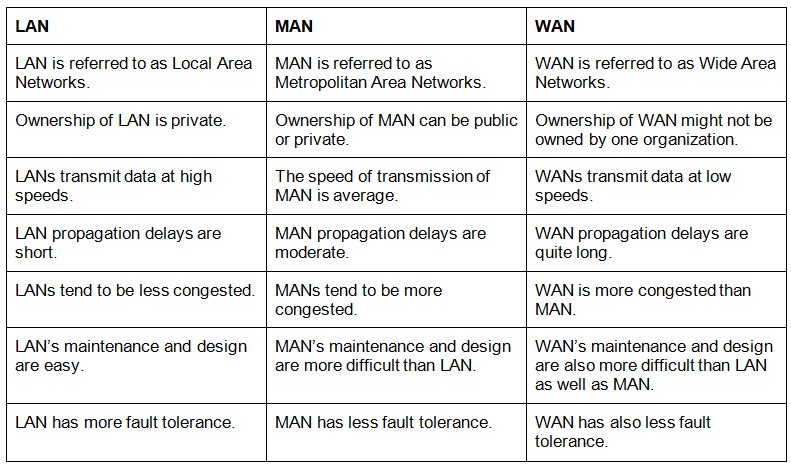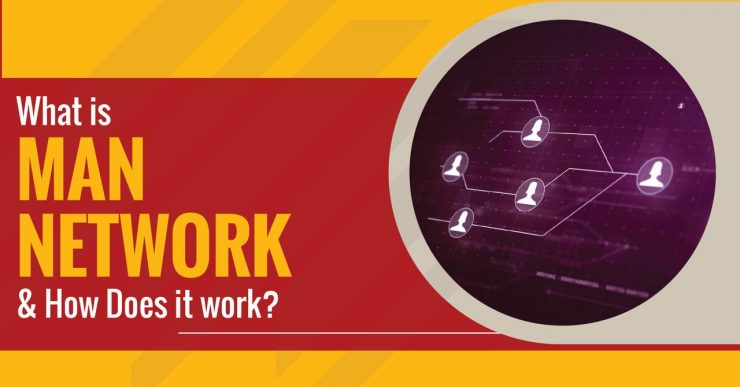Table of Contents
What is MAN Network?
The metropolitan area network (MAN) is similar to a local area network (LAN), but it extends to a whole city, campus, or city, or other government or organization territory.
Multiple local area networks are connected to form MANs, which are larger than LANs, but smaller than wide-area networks (WANs), which can cover vast geographical expanses and connect users around the world directly.
Communication through a MAN is generally fast and can be provided with high-speed carriers, such as fiber optic cables. As wireless phones and subsequent networks get introduced, a broader variety of means for transmitting signals is becoming available.
A metropolitan area network (MAN) usually covers an entire city center or campus in computer networking. It connects LANs using high-speed backbone technologies, such as fiber optics and provides up-link services to the wide-area network (WAN) and the internet.
Data transfers are moderate in speed and propagation delays are moderate as well in metropolitan area networks (MANs). MANs have less fault tolerance and more congestion in their networks. MANs are costly and may or may not be owned by one organization.
This MAN provides coverage of between 10 to 50 km using a wide network, making it ideal for building a connection between offices in a single city, factories/agencies, and the corporate headquarters within its ability to reach.
MANs transmit data using different devices, such as modems and wires/cables. Examples of MANs are the telephone company’s high-speed DSL network or the cable company’s local network.
Characteristics of MAN network
There are many and varied applications of the Metropolitan Area Network (MAN); the main uses of man network are:
- In metropolitan areas, deployment of VoIP services (Voice over Internet Protocol) will eliminate the “obsolete” lines of analog telephony or ISDN, thus eliminating the current expenditure on these lines.
- It is an interconnection of the local area network (LAN).
- With the deployment of Wi-Fi zones without a wireless backhaul (Femtocell) all Wi-Fi channels can be accessed, which in practice means a 60 percent increase in the connection of Wi-Fi users.
- Easier computer to computer interconnection.
- Systems for local video surveillance.
- CAD / CAM transmission.
- Walkways for wide area networks (WAN).
- In general, networks range in size from 5-50 km. It could encompass a small number of buildings on campus to an entire city.
- A MAN is generally owned by a user group or a provider who provides service to users, as opposed to a single organization, as is the case in LANs.
- It facilitates the sharing of resources within a region.
- Their purpose is to connect LANs with WANs and the Internet.
- Data rates of MAN are moderate to high.
- Additionally, metropolitan area networks guarantee high-quality voice, data, and video transmission. This is why corporations with multiple departments within the same capital city need to install such networks.
How MAN Network Works?
In MAN, the goal is to develop a communication link between two independent LANs, as it is larger than LAN but smaller than WAN. metropolitan area network (MAN) generally combines LAN and WAN to seamlessly connect geographically dispersed LANs.
In MAN networks, optical fiber is typically used as a medium for transmission. Routers and switches facilitate the data distribution through their ports. A switch is responsible for the filtration of the data that is sent in frames.
You can read also: What is Telecommunication Network and Types of TCN?
Switches act as dual-port devices, as they handle filtration of data at one end while at the other end they manage connections.
Routers are also involved in facilitating the network connection because they identify the path that data packets are to be routed along. In other words, a router monitors the information transfer. The Metropolitan Area Network (MAN) usually has a coverage area of up to 50 kilometers.
Function and Purpose of MAN
- Construction and implementation of a networking system that establishes contacts between servers to communicate the network used by businesses and governments so that they can participate in activities like chat, messenger, video, and others.
- There are many types of computer networks, but MAN is most commonly used for connecting across cities. To create a Metropolitan Area Network (MAN), telecommunications operators are required to connect computer networks across miles.
- Through the MAN Computer Network, communication will become more efficient, the business will be easier, and the network will be safer as well.
- Integrated with a cable television or radio network, and it supports text and voice data.
- MAN’s main purpose is to connect computer networks from one city to another.
What is the difference between LAN, MAN, and WAN?
There are three types of Networks: LAN, MAN, and WAN.
LAN or local area network allows you to communicate between various devices connected to a LAN. Private ownership controls what you can do with a local area network rather than the public.
You can read also: What is Local Area Network, Types, and Benefits of LAN?
In contrast to MAN and WAN, LAN has a short propagation delay. As a result, it covers the smallest areas like colleges, schools, hospitals, etc.
MAN or Metropolis area network consists of a larger area than the local area network, as it covers large towns, cities, etc. A MAN connects two or more computers within the same city or in different cities. Metropolis area networks are expensive and shouldn’t be owned by one organization.
WAN or Wide area networks cover a wider geographical area than local area networks and can even cover a country or continent. They are expensive and should not be run by one organization alone. WAN typically uses PSTN or satellite communication.
Let’s have a look at the Difference between the LAN, WAN, and MAN.

Uses of Metropolitan Area Network
Uses of MAN are:
- Used in Digital cable television.
- Used in government agencies.
- University campuses.
- Cable broadband.
- A network of fire stations.
- Used in airports.
- Used to provide Internet connectivity for LANs in a metropolitan region.
- Used to link various branches of the local school.
- Used in hospitals (for communication between doctors, research offices, labs).
- Networking between community colleges within the country.
- Used in public libraries.
Metropolitan Area Network (MAN) Examples
WiMAX or IEEE 802.16, are the two examples of MANs that provide high-speed broadband access with Internet connectivity to customer premises.
In recent years, the rapid development of computers (informatics), as well as the development of telecommunications technology, have created an electronic revolution that can spread news or data around the world at light speed.
As a result of the information revolution, which combines science and technology, wealth has been transformed, no longer being based on material wealth, as in the era of industrialization, but on information.
Moreover, as evidenced by a large number of firms/organizations that use computer networks in the organization and communication of data, many companies have realized the importance of utilizing these technological advances. One of the main examples is the Geological Survey Center (PSG) agency.
Advantages of MAN
The Advantages of MAN are as follows:
- High Speed: Data transfer rates for files and databases are fast due to MAN’s fiber-optic communication. Transmission speeds can reach 1000 Mbps quickly.
- Internet sharing: The installation of MANs allows users to share their internet access so that many users can have access to high-speed internet.
- High Security: Compared to WANs and LANs, it offers high security, the data in MAN are usually safe.
- Less expensive: MAN can be easily connected to the WAN network because it is less expensive. It provides strong data efficiency. All MAN data can be easily managed centrally.
- Sending Local Emails: MAN allows you to send local emails quickly and for free.
- Conversion of LAN to MAN is Easy: In MAN, two or more LAN networks are joined together. Thus, it is a quicker method for connecting two LAN networks. The process is made possible by the speed of the links.
Disadvantages of MAN
The disadvantages of MAN are as follows:
- Internet Speed Difference: The fiber optic network cannot use copper wires because copper wires slow down MAN. Therefore, fiber optic networks cost higher than copper wires.
- Difficult To Manage: As the size and number of LAN networks increase, it becomes very difficult to manage. The reason is due to additional configuration problems and security concerns.
- High risk of hacking: There are more risks of attacks from hackers on MAN than on LAN. Therefore, the need for high-security personnel is important.
- Technical Staff Requires to Set up: To configure MAN, highly technical people will be required. The technical people will be network administrators and troubleshooters.
- Need More wires: Cables are required in MAN more than LAN networks. Because we know that MANs are a combination of two LAN networks.
Conclusion:
In conclusion, a network uses telecommunications systems to link computers together in a way that enables communication and sharing of resources. Organizations would be unable to share resources as well as increase productivity without a network.
With WANs, companies could connect to the Internet from a wide area; they could hold video conferencing sessions over the country, and share data over the LAN.
Whereas, the metropolis area network covers higher populations than the local area network since it connects towns, cities, and other large populations. Metropolis area networks are costly and require multiple organizations to operate them.
It is clear from the above explanation that networks offer many benefits to the end-user. Whether the network is wireless or wired, they are an integral part of technology.




